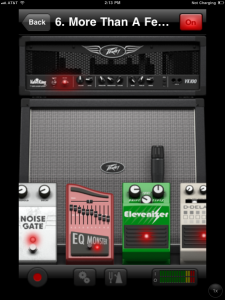This project just got a whole lot easier.
I have always been a huge iPhone fan, and I’ve had an iPad for a few months now, so I’m always looking for new useful apps. I found one last week that is an utterly indispensable tool for guitarists. It’s made learning and recording these solos much, much easier.
 The program is called AmpKit and it’s made by AgilePartners, the developers who created Guitar Toolkit, which I’ve had for a couple of years. It’s an amp and effects simulator that models real-world amplifiers, effects pedals, speaker cabinets and microphones, giving you a wide range of latitude in creating different guitar sounds, from simple and clean to raunchy and hard. I’ve only been playing with it for a short time, but it’s already made a huge difference in how I approach my practice.
The program is called AmpKit and it’s made by AgilePartners, the developers who created Guitar Toolkit, which I’ve had for a couple of years. It’s an amp and effects simulator that models real-world amplifiers, effects pedals, speaker cabinets and microphones, giving you a wide range of latitude in creating different guitar sounds, from simple and clean to raunchy and hard. I’ve only been playing with it for a short time, but it’s already made a huge difference in how I approach my practice.
In addition to the amp simulation, it has full recording capabilities, and I can upload audio files as backing tracks that I can play over. When I record a track, I can tweak the amp settings as much as I want after I’ve recorded it (it keeps the dry guitar signal). When I have the recording exactly how I want it, I can pull the file off via a web browser or upload it to SoundCloud. Then I can mix it in Audacity with the backing track (which synchronizes perfectly) and drop the mixed audio into iMovie to get a much better sound than I’d been getting with my camera’s crappy mic.
You can see the results on my last performance of Take It on the Run.
I purchased the AmpKit LiNK adapter ($29.99 from Amazon) that allows me to plug my guitar directly into my iPad and connect a headphone or external amplifier to monitor the output. I like to stand my iPad up in the dock connector and use the dock’s audio out to run to my amp or headphones. It’s a sweet setup that makes me much more efficient while practicing and recording.
They are supposedly coming out with a universal app that’s built for iPad in addition to the iPhone, and I can’t wait to see how they use the additional screen real-estate. The iPhone version looks a bit pixellated and cramped on the iPad. I hope they also consider adding the ability to share set-ups between users and moving pedals and amps between different installations of the program (ie, on my iPhone).
Note: There are two versions of the program, the free version (AmpKit) and the paid version (AmpKit+ for $19.99) — they are exactly the same except that the paid version is bundled with a good collection of amps and pedals, while the free version has only a couple. Both allow in-app purchases to add to your collection. Note that if you purchase an amp or effect in the free version it does not transfer over to AmpKit+. (I was able to get a refund from Apple, but it’s still kind of a hassle).



